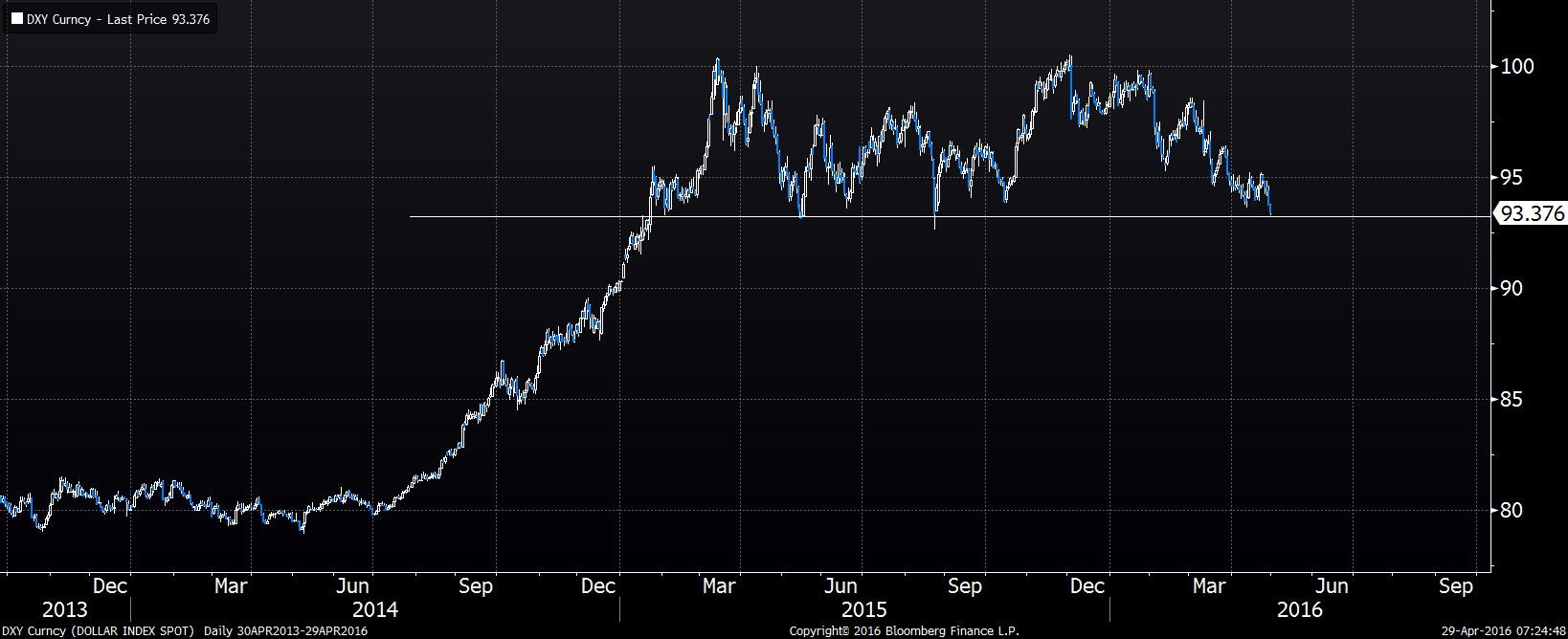Daily Comment (April 29, 2016)
by Bill O’Grady and Kaisa Stucke
[Posted: 9:30 AM EDT] The primary feature of today’s financial markets is dollar weakness.
This chart shows the CME dollar index, which is comprised of about 56% EUR and correlates at nearly +80% with the EUR/USD exchange rate. The dollar began to rally in mid-2014 as the U.S. economy began to improve and Fed policy stimulus began to wane. At the same time, weaker Japanese and Eurozone inflation led to increased policy stimulus by the BOJ and ECB, leading to a dollar bull market. The dollar has been consolidating after peaking in March of last year. Recent weakness is putting the index at the support line experienced over the past year and a break below this support line would likely prompt technical selling.
Although it is difficult to prove, we have been suggesting the Fed is using the dollar as a policy target. After all, by any measure of the Phillips Curve, the FOMC should be raising rates at least twice this year if one believes the employment/population ratio is the best reflection of the labor markets, and should be moving aggressively if the unemployment rate is the best reflection. Since the Fed doesn’t seem to be using the Phillips Curve, it has to be focusing on something and the dollar is a plausible alternative. We note today’s WSJ has an op-ed from Kevin Warsh, former Fed governor, speculating as we are that the FOMC is targeting the dollar for policy purposes. Of course, the key unknown is what exchange rates the Chair has in mind for raising rates but if we break support, we might find out in rapid fashion.
The editorial pages in most major news outlets are reacting to the growing likelihood that Donald Trump will be the GOP candidate for president. There is much discussion about his recent foreign policy address, which we would view as mostly Jacksonian in nature. In other words, isolationist with a very strong military. The key campaign slogan is “America First,” likely an inadvertent reference to an earlier America First movement that was dead set against participating in WWII. Many pundits are treating the earlier version with derision, tying it to its now discredited chief spokesman Charles Lindbergh. However, it should be noted that, at its peak, it had 880k paying members, including future presidents John Kennedy and Gerald Ford, future Supreme Court Justice Potter Stewart, Sargent Shriver, General Wood of Sears-Roebuck, the publisher of the Daily News, Joe Patterson and the publisher of the Chicago Tribune, Robert McCormick. Walt Disney and Frank Lloyd Wright were also members. Simply put, the America First movement wasn’t a den of kooks…it has a rich history that was only discredited after the U.S. abandoned isolationism and accepted the burden of global hegemony.
We believe that the wave is turning. Due to intergenerational forgetfulness, today’s Americans are keenly aware of the costs of hegemony but have taken the benefits for granted. It isn’t just Trump who is touting a return to isolationism. Rand Paul represents a similar strain and Sen. Sanders’s foreign policy wouldn’t be much different. Sen. Clinton represents the neo-conservative Wilsonian vision of America keeping the world safe, which is probably a fading position.
What is interesting to us is while the American media is fixated on Trump, it is failing to notice a growing degree of anti-Americanism in Europe. This is most evident in the strong opposition to the Trans-Atlantic Trade and Investment Partnership (TTIP) in Germany. The TTIP is the European version of the Trans-Pacific Partnership, which has been tentatively approved. Essentially, these are free trade zones that would become the new trade framework for the world. In Germany, support for TTIP is down to 17%, compared to 55% just two years ago. Given that Germany is an exporting power, it seems rather odd it would oppose an expansion of trade. However, in today’s FT, Stefan Wagstyl argues that Germany’s opposition is rooted in growing anti-Americanism and anti-globalism. Perhaps the Germans and other Europeans are also suffering from intergenerational forgetfulness, concluding that they can handle a resurgent and belligerent Russia without U.S. support.
Finally, the NYT reports that there are growing voices calling for a partition of Iraq. We have suspected this would be the eventual outcome from the minute U.S. troops entered the country in 2003. Iraq was never a natural nation. Instead, it was an artificial construct created by British and French diplomats primarily for the purpose of colonial control. The only way such a nation could be held together was either by outside force or internal authoritarianism. In the absence of either, there seems little reason for current borders to be maintained. The problem is that a three-part Iraq will be difficult to defend from outside powers, and so partitioning will likely lead to a battle for territory between Iran, Saudi Arabia and Turkey.



